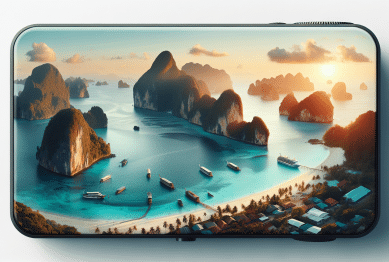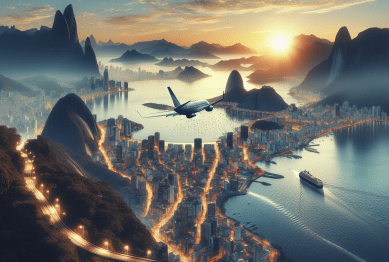Unlock the secrets to planning budget-friendly solo trips that are both safe and memorable. This guide reveals how to choose destinations, navigate accommodation options, and maximize travel rewards to help you enjoy enriching, wallet-conscious journeys—solo travel has never felt more possible or rewarding.
The Rise of Solo Travel and Its Lasting Appeal
Solo travel is attracting more adventurers each year. Many discover that venturing out alone opens unexpected doors. Flexibility and self-discovery define these journeys. Travelers set their own schedules, choose attractions that ignite their passion, and meet people they may never have encountered in group settings. Solo trips often inspire confidence and resilience. Adjusting plans on the fly becomes natural, helping many grow more adaptable. Safety, while once a concern, is now better addressed thanks to technology and detailed travel guides (https://www.afar.com/magazine/how-to-travel-alone).
Many countries now cater specifically to solo explorers. Japan, Portugal, and Canada have robust resources to help newcomers navigate transport, accommodations, and attractions. Solo travelers can leverage curated group day tours for local insights yet return to solo time at day’s end. Community forums introduce new friends. Many travelers find that forging solo itineraries provides a unique sense of freedom, making each trip personal. The search for safe destinations and affordable accommodation empowers those who want control over their travel experiences.
Changing lifestyles and remote work are also fueling the solo travel trend. With remote jobs, it’s easier than ever to blend work with wanderlust. Coworking hostels across Europe or Southeast Asia are designed with solo travelers in mind. These properties provide fast Wi-Fi, communal kitchens, and organized activities. When solo, travelers often uncover their preferences—like sunrise hikes or late museum visits—without compromise. The experience becomes truly personalized, making solo travel more than just a trip; it’s an investment in oneself.
Choosing Your Destination Wisely for Solo Travel
Destination choice shapes the entire trip, especially for the solo traveler seeking value and safety. Many prefer cities known for efficient public transportation, a welcoming atmosphere, and a lower cost of living. Consider places like Lisbon, Bangkok, or Budapest for vibrant food scenes and affordable attractions. Each city reveals distinct cultural gems. Checking local regulations and reading recent travel advisories helps travelers prepare smarter and minimize surprises (https://travel.state.gov/content/travel/en/international-travel.html).
Solo travelers looking for nature escapes often select national parks outside tourist high seasons. U.S. parks like Zion, or Canada’s Jasper, offer solitude and scenic beauty without bustling crowds. Regional tourism boards sometimes offer passes that include discounted transport and activities. Exploring local villages or coastal regions outside capital cities can also lead to authentic experiences. Food markets, festivals, and guided walks allow solo adventurers to connect with communities. Travelers share stories and tips in online forums or through official tourism office resources.
Choosing the right accommodation is vital. Many solo travelers opt for hostels or boutique hotels with vibrant communal spaces. These spots frequently host language exchanges, cooking classes, or walking tours that encourage swapping travel stories. For added peace of mind, look for properties with 24-hour reception or listed on verified booking platforms. Considering location, nearby amenities, and reviews from other solo visitors adds another layer of safety and enjoyment. These decision points empower solo travelers to focus on enjoyment—and discovery—over logistics.
Saving on Travel: Flights, Rewards, and Transportation
Solo travel offers flexibility that group trips rarely match. Flexible dates open doors to flight deals and off-peak rates. Savvy travelers use fare comparison engines and sign up for airline alerts to catch sales on major routes. Traveling mid-week or booking toward the start of tourist off-season often results in lower costs. Many solo adventurers maximize frequent flyer programs to turn previous trips into future savings. Some independent travelers use credit cards that accumulate miles or offer travel perks, shaving costs off big-ticket expenses (https://thepointsguy.com/guide/solo-travel-for-beginners/).
Transportation within a destination influences both cost and experience. In cities, day or week metro passes frequently save money compared to individual fares. Renting bikes for a few hours or days provides a flexible way to explore, and many cities have safe, bike-friendly routes. If traveling across multiple regions, look for regional rail or bus passes—Europe’s Eurail or Japan’s JR Pass are affordable options for explorers who plan several stops. Carpooling platforms sometimes offer budget-friendly rides between municipalities, letting solo travelers split expenses and meet locals en route.
Getting around safely remains a priority. Many travelers rely on reputable ride-share apps, booking transport in advance or during daytime hours for added confidence. It’s always wise to download local transport apps or offline maps before departure. Combining several cost-saving strategies—like pairing short-distance intercity train tickets with discount attraction passes—helps ensure the journey is both affordable and convenient. By making smart choices with flights, rewards, and ground transport, independent adventurers enjoy more destinations without breaking their budgets.
Accommodation Choices That Enhance Solo Journeys
Where you stay matters—especially when traveling alone. Hostels are increasingly sophisticated, with private and shared room options, modern amenities, and strong security measures. Social activities are common, from communal dinners to film nights and guided city walks. It’s easy to connect with other solo travelers and share recommendations. Platforms such as Hostelworld and trusted review sites make it easy to compare facilities, locations, and guest ratings. This transparency provides peace of mind when booking and checking in (https://www.hostelworld.com/blog/solo-travel-tips/).
For those who prefer more privacy, boutique hotels or short-term rental apartments offer flexibility without sacrificing safety. Many properties are situated in central areas, reducing transportation needs and allowing easy access to attractions. Look for accommodations with in-room safes, 24-hour access, and strong guest reviews regarding staff helpfulness. Some solo travelers opt for women-only hostels or guesthouses for added comfort. Participating in organized hostel or hotel activities, like group hikes or culinary workshops, blends personal time with opportunities to form new connections.
Platforms like Couchsurfing and local homestays introduce a more immersive experience, allowing travelers to live with locals and learn about their customs. Reviews and host verification features are essential for safety and enjoyment. Choosing accommodations with communal kitchens can cut meal costs and make it easy to prepare favorite snacks or regional dishes. By considering security, location, amenities, and social offerings, solo travelers find spaces that match their style—making each night as memorable as the day’s adventures.
Nutrition, Wellness, and Staying Healthy While Traveling
Nutritional choices play a key role in how enjoyable solo trips can be. Many travelers are drawn to street food and local markets, where sample-sized snacks and home-cooked meals offer insight into the culinary heartbeat of each destination. Safety is important—opting for busy stalls and filtered water reduces risk. Packing basic items like reusable cutlery, a water bottle, and simple first-aid essentials ensures convenience and peace of mind. Staying hydrated and carrying nutritious backups like nuts or fruit supports energy for sightseeing demands (https://www.cdc.gov/travel/page/food-water-safety.html).
Wellness routines don’t always pause on the road. Solo travelers increasingly take yoga classes, hike local trails, or join walking tours to combine movement and mindfulness. Checking for parks or public gardens in advance allows for daily exercise—even in unfamiliar cities. Many download wellness apps or podcasts for relaxation or stretching in their rooms. Travel insurance is a wise investment, as it covers unexpected illness and supports confidence. The combination of mindful eating and movement helps solo travelers maintain well-being across time zones and climates.
Mental health should not be overlooked. Journaling, keeping in touch with loved ones, or practicing meditation builds resilience and preserves a positive mindset. Many travelers set digital boundaries, choosing when to be offline to truly experience new surroundings. Connecting with supportive online communities provides access to advice and reassurance. Setting aside downtime for relaxation makes each solo adventure more balanced. Prioritizing physical and mental health empowers every traveler to feel at home, no matter where the path leads.
Maximizing Experiences: Cultural Immersion and Personal Growth
Cultural immersion distinguishes good trips from great ones. Solo travelers, unencumbered by group dynamics, often dive deeper into local customs. This might mean joining a traditional cooking class, visiting a community art project, or attending neighborhood festivals. These hands-on activities foster understanding and break down barriers. Language barriers are less intimidating—travelers use translation apps or pick up essential phrases rapidly, showing respect and curiosity. Museums and galleries provide structured insight into a place’s soul, yet lingering in a café or market often leads to meaningful exchanges (https://www.lonelyplanet.com/articles/solo-travel-tips).
Personal growth is a natural outcome of navigating unfamiliar places alone. Daily challenges—finding the right bus, ordering at a local eatery—become achievements. Confidence increases with each challenge met. The process encourages adaptability and a broader worldview. Unexpected friendships form, and acts of kindness from locals become treasured memories. Solo travel gives space for reflection, creativity, and independence. Over time, these moments help shape new perspectives and stronger self-awareness, sparking enthusiasm for future adventures.
Giving back rounds out the experience. Some travelers participate in responsible tourism, such as beach cleanups or cultural preservation efforts. Responsible travelers research companies committed to ethical tours and giving back to local communities. Making eco-friendly choices, like using public transportation or reducing single-use plastics, leaves destinations better for future visitors. Solo travelers increasingly champion a positive impact mindset, connecting travel with cultural respect and personal fulfillment. The journey continues to give, well after returning home.
References
1. AFAR Media. (n.d.). How to Travel Alone: Solo Travel Tips. Retrieved from https://www.afar.com/magazine/how-to-travel-alone
2. U.S. Department of State. (n.d.). International Travel Information. Retrieved from https://travel.state.gov/content/travel/en/international-travel.html
3. The Points Guy. (n.d.). A Solo Traveler’s Guide for Beginners. Retrieved from https://thepointsguy.com/guide/solo-travel-for-beginners/
4. Hostelworld. (n.d.). 18 Top Tips for Solo Travel. Retrieved from https://www.hostelworld.com/blog/solo-travel-tips/
5. Centers for Disease Control and Prevention. (n.d.). Food and Water Safety. Retrieved from https://www.cdc.gov/travel/page/food-water-safety.html
6. Lonely Planet. (n.d.). Tips for Traveling Solo for the First Time. Retrieved from https://www.lonelyplanet.com/articles/solo-travel-tips









